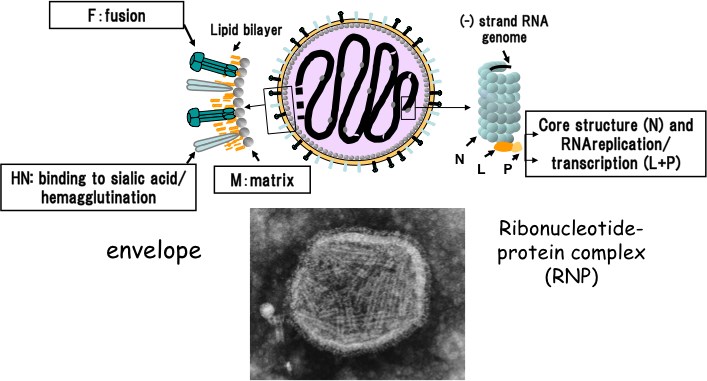Sendai Virus
Targeting vectors pseudotyped with distinct viral envelope proteins that influence cell tropism and transfection efficiency has been treated as a useful tool in the field of gene therapy. Up to now, numerous lentivirus vectors pseudotyped with different glycoproteins have been constructed for the treatment of multiple diseases. As a pioneer company in this field, Creative Biolabs is capable of offering comprehensive lentiviral vectors construction and optimization services for worldwide customers. Here, we are happy to introduce our lentiviral vector pseudotype derived from Sendai virus (SeV) glycoprotein.
Sendai Virus (SeV)
SeV, also known as mouse parainfluenza virus type 1 or hemagglutinating virus of Japan (HVJ), is a nonsegmented negative-strand RNA virus belonging to the Paramyxovirus family with a large spherical shape and an average diameter of 260 nm. SeV has two glycoproteins, HN and F proteins. HN is for attachment of the virus to cellular receptors and F is for cell fusion. Early studies have demonstrated that SeV could efficiently overcome a series of extra- and intracellular barriers in the respiratory tract, such as the glycocalyx, mucus layer, mucociliary clearance, and cell membranes. In addition, the Sendai virus F envelop protein (SV-F) is capable of binding specifically to the hepatic asialoglycoprotein receptor (ASGP-R), mediating the fusion of the viral envelope with the cell membrane.
 Figure 1. Schematic model and electron microscope photograph of SeV. (Morodomi, 2013)
Figure 1. Schematic model and electron microscope photograph of SeV. (Morodomi, 2013)
LVs Pseudotypes Bearing SeV-derived GPs
SeV is enveloped with fusion (F) and hemagglutinin-neuraminidase (HN) proteins. Since isolation in 1950s, recombinant SeV has been applied in multiple areas for basic and applied biology, such as preparation of hybrid cells and large-scale production of interferon (IFN). Recently, incorporation of heterologous envelope proteins into the virus particles becomes an important factor for the production of functional pseudotyped lentivirus vectors. In view organ and tissue tropism of SeV, SeV glycoprotein- pseudotyped vectors are expected to show expanded cell tropism, making them ideal tools for gene therapy, including therapy for respiratory diseases and hepatoma. Particularly, pseudotyped lentiviral vector derived from simian immunodeficiency virus SIVagm with SeV envelop glycoprotein has been confirmed to transduce various types of animal and human cell lines, which provides a new tool in gene therapy for various therapies.
Services
Focusing on gene therapy for years, we have constructed and optimized numerous glycoprotein-based lentiviral vectors for global customers. With abundant experience, our professional scientists will help you select optimal virus type and glycoprotein for targeting specific cells or tissues to promote the development of your gene therapy programs. The vectors we are providing are characterized by:
- Broad host range: high-efficiency infection of dividing and nondividing cells
- Long-term stable expression of a transgene
- Low immunogenicity
- Low cytotoxicity
Creative Biolabs is devoted to offering safer and higher vectors to promote your project a success. Please feel free to contact us for more details or directly send us a quote.
Reference
- Morodomi, Y.; et al. (2013). Sendai virus-based oncolytic gene therapy. In Novel Gene Therapy Approaches. IntechOpen.
